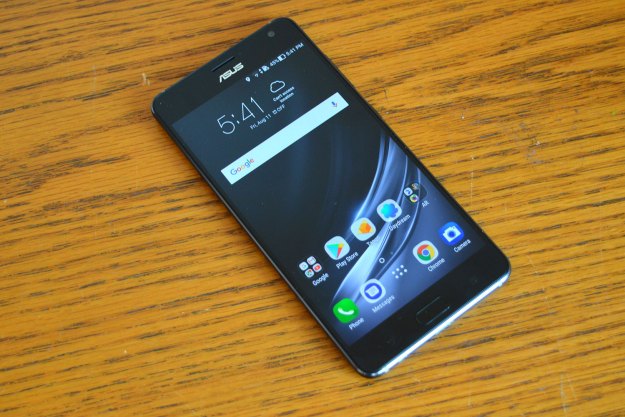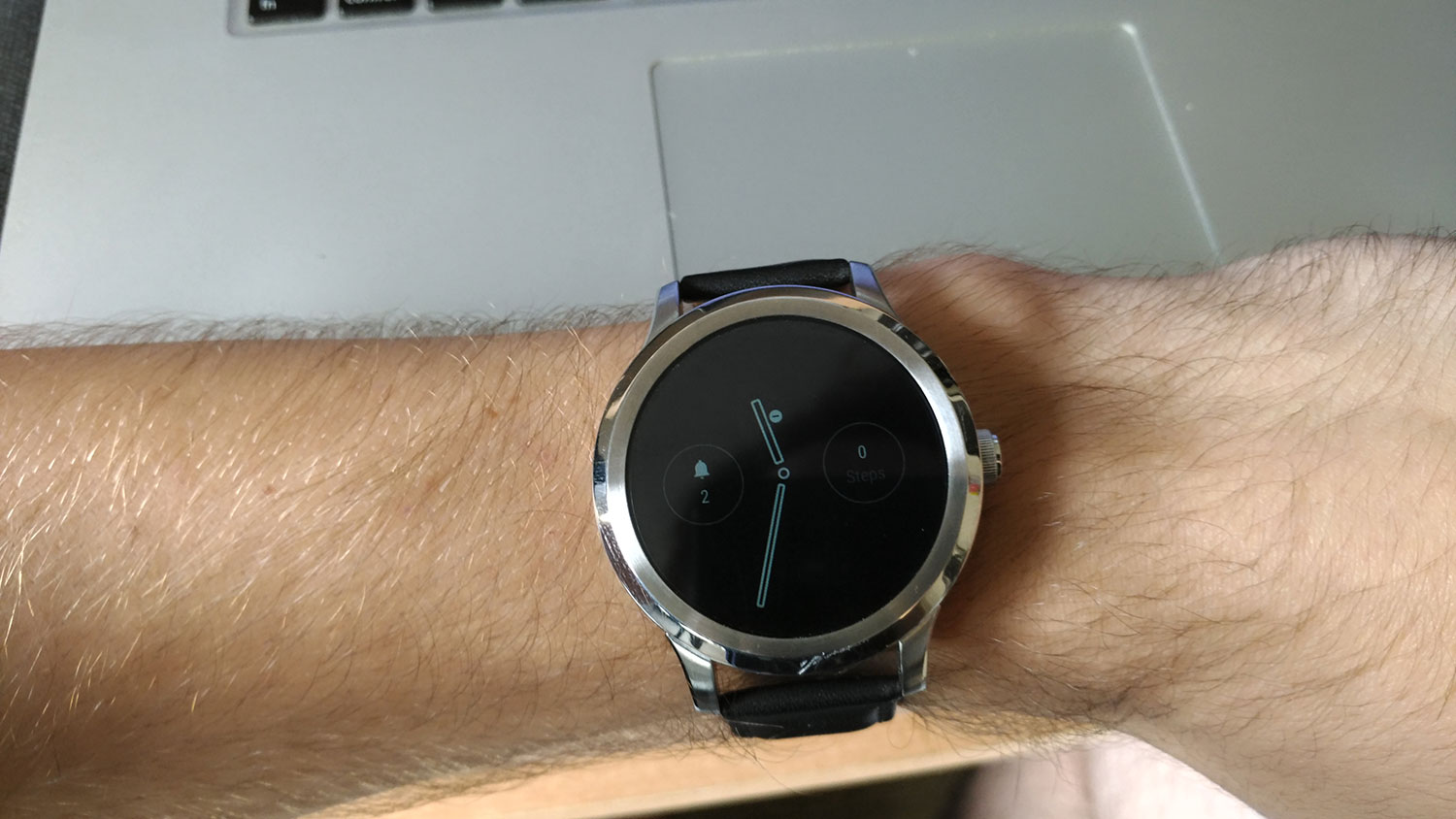
“Augmented reality can't quite save Asus' Zenfone AR from its boring design and excessive price.”
- Good camera
- Snappy performance
- Great display
- Expensive
- Annoying user interface
- Boring design
- AR is gimmicky
Google wants to make augmented and virtual reality a little more accessible to the masses through its Android mobile operating system. It has succeeded somewhat with VR, through its Daydream VR platform. Slap phones like the Samsung Galaxy S8 or a Google Pixel into the Daydream View headset and you can be transported to different worlds in VR. With AR, Google initially had a project called Tango, which used special cameras to view digital objects in the real world, similarly to Pokémon Go. Asus and Lenovo created phones to utilize Tango technology, but so far the AR apps and features have largely been gimmicky.
Google also just announced ARCore, a platform that brings AR capabilities the company learned from Tango, to phones running Android 7.0 Nougat and higher — without the need for special hardware. As we found in our Asus Zenfone AR review, there’s no reason to opt for the phone over other Nougat-level Android devices thanks to Google’s latest initiative.
Great display, boring design
The Zenfone AR doesn’t look all that exciting, especially compared to smartphones embracing the edge-to-edge “bezel-less” screen design, like the Essential Phone, or the Galaxy Note 8.
On the front of the phone, the 5.7-inch screen is protected by Corning’s Gorilla Glass 4. The home button below the screen doubles as a fingerprint sensor, and it’s flanked by capacitive navigation buttons. On the left edge of the phone, you’ll find the power button and volume rocker, while the right edge houses the SIM card slot. There’s thankfully a headphone jack; it’s on the bottom of the phone next to a USB Type-C charging port.
On the rear, you’ll immediately see the camera module is what makes this phone unique. We’ll dive into the specs of the camera later, but as far as design goes there are three lenses and sensors for depth and motion – all of which contribute to augmented reality via the Google Tango software.
It’s not a bad-looking phone, but it’s pretty boring in the design department.
The fingerprint sensor picked up our print accurately, and while it isn’t the fastest around, it’s not slow enough to be a problem. But there are more practical issues with the phone’s design, such as how there’s no waterproofing. Waterproofing is a feature available on most flagship phones $600 and higher, and it’s disappointing when a phone at this price isn’t IP-rated at all.
The Zenfone AR doesn’t just support Tango; it’s also a Daydream-ready phone. That means the quality of the display is important for virtual reality viewing, and thankfully it delivers. The 5.7-inch AMOLED display offers a resolution of 2,560 x 1,440, with a pixel density of 515 pixels-per-inch. It looks great, with bright colors, deep blacks, and crisp images.
We’re happy with the Zenfone AR’s display, and while the phone feels good in the hand, we’re a little bored by its traditional design — triple cameras and all.
Snappy and smooth performance
Under the hood, the phone packs the aging Qualcomm Snapdragon 821. It’s the same chip that’s in the Google Pixel, and it isn’t a low-performer. For this price though, many would expect the Snapdragon 835, Qualcomm’s 2017 flagship processor. Regardless, the Zenfone AR packs 6GB or 8GB of RAM (you can choose how much you want), which is likely more than you need. The model we’re reviewing has 8GB of RAM and 128GB of storage, and there’s even a MicroSD card slot in case you want even more storage.
Here’s how the phone performed in benchmarks.
- AnTuTu: 156,874
- Geekbench 4: 1,801 single-core, 4,322 multi-core
- 3D Mark Slingshot Extreme: 2,703
For the price, there are definitely higher performing phones. The OnePlus 5, for example, comes at $480 and hit a massive 181,599 on AnTuTu in our review. Interestingly enough, the Samsung Galaxy S8 scored 155,253 on AnTuTu, while the Google Pixel XL, which also has a Snapdragon 821 chip, scored 138,946.
Now, always take benchmark results with a grain of salt. Different phones handle benchmarks differently, and OnePlus was even recently accused of cheating on its benchmark results. In reality, what matters is how the device performs in real life, and we had very few issues with it. There were occasional stutters, but general performance was snappy and smooth, even while playing graphics-intense games and using processor-hungry apps.
Solid camera
The triple cameras on the rear all help with depth sensing for augmented reality, and it’s the highlight feature of the smartphone.
The primary sensor features 23 megapixels with optical image stabilization, which helps it shoot decent photos in low-light situations. We were impressed with the quality of the shots, especially considering the somewhat lackluster quality we saw in our last Asus phone review, the Zenfone Zoom.
What matters is how the device performs in real life, and we had very few issues with it.
But despite the unusual triple rear-facing camera, the camera app only utilizes one. The multiple sensors only work for AR capabilities and nothing else. For example, instead of using one of the cameras to measure depth to create a blur effect like on the iPhone 7 Plus, the main camera instead takes multiple photos with different points of focus to create the same effect.
Regardless, the results from the camera are solid. Photos feature plenty of dynamic range and colors look natural – even when HDR mode is on. There’s even a so-called “HDR Pro” mode, which is built to increase detail and produce richer colors. These photos look decent, but we prefer the shots taken with the standard HDR mode.
The 8-megapixel front-facing camera is just about average, capturing a good amount of detail.
Augmented and virtual reality
The whole point of this phone has nothing to do with how well-designed it is, or even how much heavy-lifting it can do under the hood – it’s how well it handles augmented and virtual reality applications.
Augmented reality lets you use the smartphone’s camera to look at the real world, with digital applications layered over. For example, point the camera at a storefront and you could see store hours as a pop up on your phone, without having to getting near the store. Think Google Glass, but in a phone. Sadly, many of these AR apps and functions aren’t as useful.
The Zenfone AR comes pre-loaded with a few AR apps, but you can also download more through the Google Tango app. Virtual objects in AR mode respond quickly to interaction, though we did encounter some stutters — a higher-powered chip may have helped here. The real problem with AR on mobile is the lack of apps. Sure, you can see what some furniture would look like in your house with the Wayfair app, but there’s only a few dozen pieces of furniture to choose from. Another example is the Wall Street Journal’s AR stock checker, which shows you a visualization of stocks in the air. Why? It’s not a very intuitive app, and it takes much longer than looking up stock prices the old fashioned way. The AR apps we’ve seen are still gimmicky; there’s absolutely no incentive to use them other than showing off the capabilities at a party.
Google’s ARCore platform will bring all these apps and services to any Android phone running Nougat 7.0 or higher, which means you don’t need the special hardware on the Zenfone AR.
Don’t forget, you can also use the Zenfone AR for VR. You’ll need a Google Daydream View headset, which you can get from Google for around $80. The Daydream experience on the phone is on par with the likes of the Google Pixel XL. There’s the VR Play Store where you can download apps and games, and the screen has a high-enough resolution that we didn’t notice any issues with image quality.
Average battery life
The battery capacity in the Zenfone AR sits in at 3,300mAh, and it should get you through a day of light to medium use. If you use your phone a little more, listening to music all day, watching videos, or using the phone for augmented or virtual reality, and you’ll see the battery suffer.
Thankfully, the phone is pretty good at charging quickly. We plugged the phone in with 19 percent remaining, and after 30 minutes it was charged up to 69 percent – that’s 50 percent charged in only half an hour. That’s not record-breaking, especially considering the small-ish battery, but it’s still pretty good and should help alleviate some of the issues with the battery life.
ZenUI is not zen
Software is increasingly important these days, and many manufacturers have been stripping the user interface down in favor of a pure Android approach. Asus hasn’t, sticking with its Android skin, or theme, called ZenUI. It’s not a bad experience, but it’s certainly not our favorite version of Android.
The phone is carrier unlocked, which means that there will be virtually no carrier bloatware. There are some handy features, like the ability to create folders in the app tray and the built-in file manager.
But we would have liked those features without the clunky look and feel, the oversized icons, and the overly bright colors. The interface is called “ZenUI,” but zen is the last thing we felt using the software. You can always download another Android launcher on the Play Store, which is always an out to having a frustrating interface, but most people don’t want to do that, nor should they need to.
Warranty, pricing, and availability
The Asus Zenfone AR is available from Amazon for $600 for the 6GB RAM/64GB storage version, or $700 for the 8GB RAM/128GB storage version. That’s a lot of money, especially for a phone with last year’s processor, and the added cost is likely due to the sensors used for AR. You can buy it from Amazon, or through Verizon, which will set you back $648 for the 8GB RAM model.
Asus offers a limited warranty, which will cover manufacturing defects a year from the date of purchase. It does not protect you from accidental or water damage.
Our Take
Augmented reality, at least on the Zenfone AR, largely feels like a gimmick at the moment. If you want a Daydream-ready phone for virtual reality, we recommend the Pixel or the Galaxy S8, which offer superior and more polished experiences all around.
Google has also announced ARCore, a new platform that brings AR capabilities to Android phones that run Nougat or higher, without the need for special camera set ups. It’s the culmination of what the company has learned through Tango, so we see even less of a reason to buy the Zenfone AR.
Is there a better alternative?
Yes. If you’re simply looking for a device that works well in day-to-day use, then we recommend the OnePlus 5, which boasts the latest Qualcomm processor as well as 6GB or 8GB of RAM — it starts at $480. If VR is important to you, then perhaps the Galaxy S8 or the Google Pixel are a better options.
If you’re excited for AR and can’t wait for its capabilities, we recommend waiting for Apple’s ARKit in iOS 11, and Google’s ARCore for Android Nougat devices and higher. If they can provide the same level of an AR experience as the Zenfone AR, without the need for depth-sensing cameras, then we recommend skipping Asus’ device.
To be fair, the Asus Zenfone AR is the only phone that can handle Tango AR and Daydream VR.
How long will it last?
The Asus Zenfone AR should get you through a standard two-year cycle, as long as you take care of it. It’s not waterproof, which is a bit of a thorn in the side of durability, but it should be able to withstand most drops and falls.
Should you buy it?
No. With Google’s ARCore bringing AR to Android phones Nougat and higher, there’s not much of a reason to endure the ugly ZenUI, boring design, average battery life, and a 2016 processor.
Editors' Recommendations
- Asus’ latest Android phone could be a big threat to the Galaxy S23 Ultra
- Lumus demonstrates futuristic 3,000-nit AR glasses at CES 2023
- Meta teases new wearable that lets you control AR with your brain
- Apple AR headset price just leaked, and it’s as expensive as you’d expect
- Google is bringing its futuristic AR glasses to the real world … kind of

















